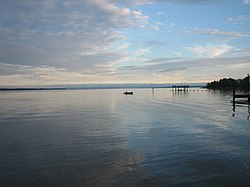
Back نهر راباهانوك Arabic نهر راباهانوك ARZ Rappahannock River (suba sa Tinipong Bansa) CEB Rappahannock Czech Раппаханнок (юханшыв) CV Rappahannockfloden Danish Rappahannock River German Río Rappahannock Spanish Rappahannock Finnish Rappahannock French
| Rappahannock River | |
|---|---|
 The Rappahannock River at sunset in October 2005 | |
 Rappahannock River drainage basin | |
| Location | |
| Country | United States |
| State | Virginia |
| Counties | Lancaster, Middlesex, Essex, Richmond, Westmoreland, King George, Caroline, Stafford, Spotsylvania, Culpeper, Fauquier, Rappahannock |
| City | Fredericksburg |
| Physical characteristics | |
| Source | |
| • location | Chester Gap |
| • elevation | 1,720 feet (520 m) |
| Mouth | |
• location | Chesapeake Bay |
• coordinates | 37°35′15″N 76°17′21″W / 37.58750°N 76.28917°W |
| Length | 195 miles (314 km) |
| Basin size | 2,848 sq mi (7,380 km2) |
| Discharge | |
| • average | 1,670 cubic feet per second (47 m3/s)[1] |
The Rappahannock River is a river in eastern Virginia, in the United States,[2] approximately 195 miles (314 km) in length.[3] It traverses the entire northern part of the state, from the Blue Ridge Mountains in the west where it rises, across the Piedmont to the Fall Line, and onward through the coastal plain to flow into the Chesapeake Bay, south of the Potomac River.
An important river in American history, the Rappahannock was long an area of occupation by indigenous peoples, including the Rappahannock Tribe. Similarly, during the colonial era, early settlements in the Virginia Colony were formed along the river.
During the American Civil War, due to the river's acting as a barrier to north–south troop movements, it effectively functioned as the boundary of the eastern theater of the war, between the "North" (the Union) and the "South" (the Confederate States of America). It was at the center of a major theater of battle where tens of thousands of troops fought against each other. In this period some 10,000 enslaved African Americans escaped to freedom across the river to Union lines, after the first Battle of Fredericksburg.
The river drains an area of 2,848 square miles (7,380 km2), approximately 6% of Virginia. Much of the watershed is rural and forested. Development in the area has increased since the late 20th century with the southward expansion of the metropolitan Washington, D.C. suburbs.
- ^ USGS data, accessed 2010-06-14
- ^ "Rappahannock River". Geographic Names Information System. United States Geological Survey, United States Department of the Interior. Retrieved December 23, 2016.
- ^ U.S. Geological Survey. National Hydrography Dataset high-resolution flowline data. The National Map, accessed April 1, 2011